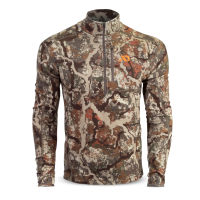
Several years ago I was sitting on a Minnesota buck tag as December rolled in. I figured filling that tag was a long shot, but I also had nothing to lose by trying. I made a plan to split my time between private and public ground with the realization that I didn’t have access to a single acre of a food plot or agricultural field.
Knowing that, I went looking. With the benefit of snow I found enough trails to justify hanging a few stands. I found after my initial hunts that I had the woods to myself. It wasn’t easy hunting, but there were some key places that held deer concentrations, and all of those places had nothing to do with abundant calories.
Throughout the process I not only filled that long-shot tag, but also helped a buddy get within range of a great public land buck. That December I learned a lot, but the most important lesson was that I didn’t need food to kill a whitetail in the late season. Aaron Hepler, a diehard whitetail hunter from Pennsylvania, agrees with that sentiment.
December Deer Details
“When it comes to late-season whitetails in my home state, I go right back to areas where I found them in September and the beginning of October,” Hepler said. “After that, I start to pay attention to the conditions. For example, if it’s sunny, wind or no wind, I’m usually looking for deer on ridge tops. If it’s cloudy, I might concentrate on creek bottoms.”
With his strategy, Hepler is not only trying to pinpoint areas the deer are most likely to use, but also figure out why they use them. His examples of hunting ridge tops in the sun versus hunting creek bottoms on cloudy days is all about deer trying to stay warm. When that’s not an option, they are likely to bury themselves in thicker geothermal cover with protection from the elements and predators.
The more granular you can get on local deer knowledge, the more it’ll inform your ambush choices. As Hepler points out, deer are going to use the available terrain and cover to their advantage in direct response to the conditions. The more you scout and hunt, the more you’ll be aware of where to set up whether it’s sunny, windy, cold, or anything in between. Deer movement in the late season isn’t random.
The Browser Advantage
Watching a buck browse past your stand in September is a vastly different observation than in December. What’s left of the browse in winter is guaranteed to be of lower nutritional value than earlier in the season (and definitely not as abundant). But that doesn’t mean deer won’t work their way through cover nibbling on woody browse like buds, twigs, and leaves.
They’re also keenly adept at identifying food sources that are good enough now but might not have been all that appealing earlier in the year. I found this out as a college student hunting public land in December when I stumbled upon some pounded trails leading into a small drainage. At the bottom, poking through the snowpack, was a patch of scouring rush horsetail, which looks like a pencil reed and stays green all through the winter.
I missed a doe while sitting on the ground that evening but since then I’ve made mental notes whenever I stumble into a patch of horsetail. It’s almost always located in low, wet areas that are thick and likely to hold deer already. I’ve never seen a deer munch on them any other time except late season. When they get on them, they really get on them.
You might also find that the deer will revisit red oak acorns that they previously ignored in favor of the white oaks or nearby ag fields. In ag-heavy areas where finding quality food throughout spring, summer, and fall is nothing more than a short walk, red oaks can really be late-season magnets. I’ve seen entire ridges turn on during late season, as well as loner trees tucked into small properties that seem to offer nothing substantive calorie-wise to surviving deer.
Remember, just because you don’t have an awesome picked cornfield to sit over doesn’t mean you automatically don’t have any food sources worth hunting. They just might not be conventional options.
Calorie-Free
If your spot really doesn’t offer anything redeemable in terms of food to hunt, don’t fret. You might just have to sit mornings as the whitetails filter through to bed. When conditions aren’t super crunchy and you’ve got well-planned access, this can be a great strategy. It takes some scouting, but when you know where deer are likely to end up, it’s just a matter of figuring out how to get in there before they do.
The thing to remember is that late-season deer are easy to pattern—and very easy to knock off their patterns. If the conditions don’t allow you to get in relatively undetected, wait for a time when they will. Play it safe, plan it correctly, and eventually you’ll get a chance to move in. Then, when the deer least expect it, you’ll be there waiting for them.
Feature image via Matt Hansen.








Conversation